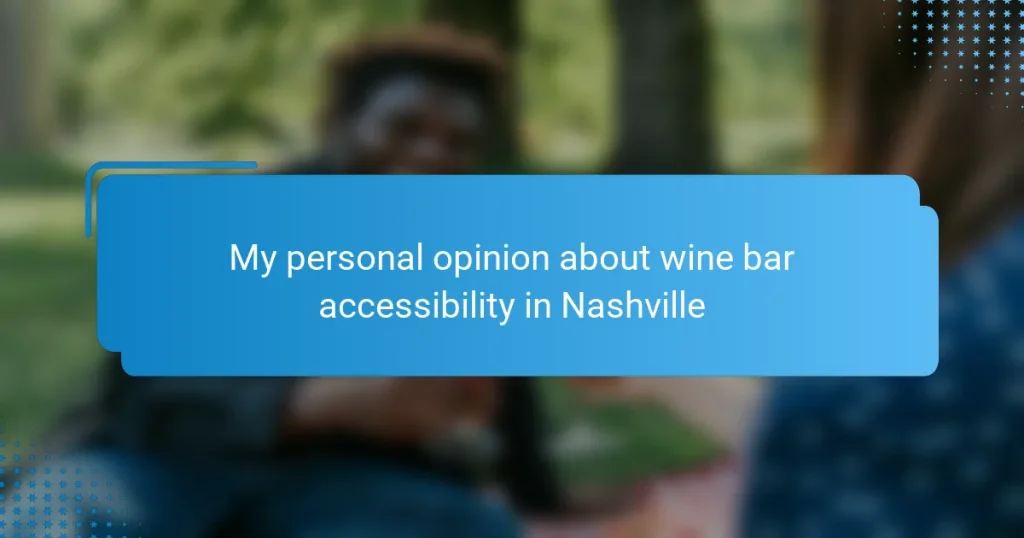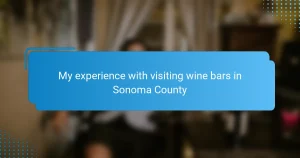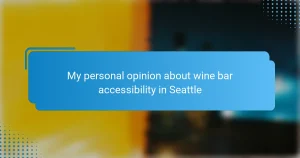Key takeaways
- True accessibility in wine bars goes beyond physical features, emphasizing the importance of atmosphere and staff attitude.
- Key factors for accessible wine bars include spacious seating, appropriate lighting, and attentive service to enhance guest experiences.
- Nashville’s wine bar scene varies in accessibility, with some venues prioritizing ambiance over comfort for all guests.
- Improvements such as leveling entrances, rethinking seating arrangements, and optimizing lighting can significantly enhance accessibility.
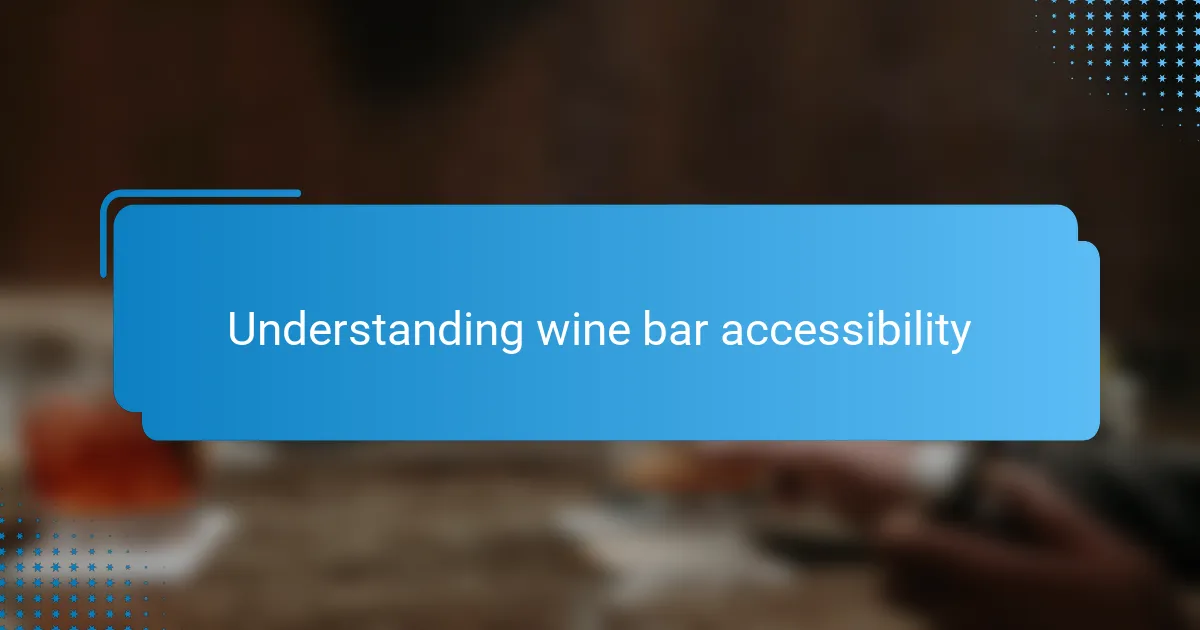
Understanding wine bar accessibility
When I think about wine bar accessibility, I’m reminded that it’s not just about ramps or elevators. True accessibility means creating spaces where everyone feels welcome and comfortable, whether that’s someone with mobility challenges or sensory sensitivities. Have you ever walked into a cozy spot only to find that narrow doorways or dim lighting make the experience difficult?
From my visits, I’ve noticed that thoughtful layouts and clear signage can make a world of difference. It’s not just practical—it speaks volumes about how much a place values its guests. Don’t you agree that accessibility should be a natural part of the design, rather than an afterthought?
Sometimes, accessibility goes beyond physical access—it’s about the atmosphere and staff attitude too. A friendly smile and willingness to assist can transform a wine bar visit from frustrating to enjoyable. I’ve found that when these elements come together, it elevates the whole experience in ways standard reviews often overlook.

Key features of accessible wine bars
One key feature I always look for in accessible wine bars is spacious seating arrangements. It might seem simple, but having enough room to navigate without bumping into tables or chairs really sets the tone. I remember a spot where I almost gave up because the aisles were so tight—nothing ruins the mood faster than feeling cramped.
Lighting plays a surprisingly important role, too. Soft but sufficient lighting helps not only with visibility but creates a welcoming vibe for those with sensory sensitivities. Have you ever been in a place so dim you couldn’t read the menu? That kind of oversight, in my opinion, signals a lack of genuine care.
And then there’s the staff’s attitude, which I can’t stress enough. When employees are attentive and open to assisting without making someone feel like a burden, it truly changes the experience. I’ve had moments in some bars where a simple gesture, like offering to describe the wine choices clearly, made me feel seen and valued. Isn’t that what hospitality should always be about?
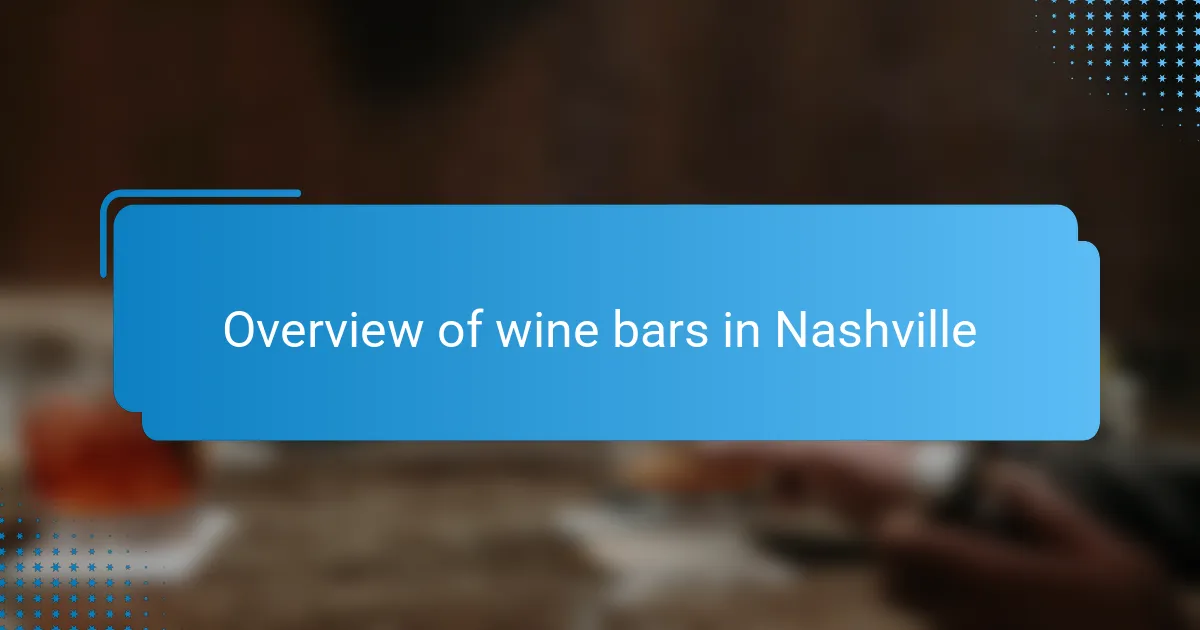
Overview of wine bars in Nashville
Nashville’s wine bars offer a fascinating mix of styles, from chic downtown spots to cozy neighborhood gems. I’ve found that many emphasize ambiance and unique wine selections, but how well do they balance that with ease of access? Walking into some places, I’ve noticed the charm, yet wondered if everyone can truly feel at home there.
In my experience, the variety in Nashville’s wine bar scene also means a range of accessibility standards. Some venues impress with wide doorways and thoughtful layouts, while others seem to prioritize atmosphere at the expense of comfort for all guests. Have you ever felt like a space was designed for aesthetics but left practical access behind?
One thing I appreciate about a handful of Nashville’s wine bars is how they incorporate accessibility into their identity. It’s not always perfect, but when they pay attention to entrances, seating arrangements, and staff readiness, it reflects a genuine commitment. I often think that these efforts make the difference between a good night out and one that feels exclusive rather than inclusive.

Personal visit experiences in Nashville
During one visit to a downtown Nashville wine bar, I remember feeling both welcomed and a bit frustrated. The entrance had a slight step that wasn’t immediately obvious, and I hesitated for a moment—have you ever experienced that awkward pause wondering if you can easily get inside? Once seated, though, the spacious layout surprised me in a pleasant way, making it easy to relax and enjoy the evening.
On another occasion, I found myself admiring a cozy neighborhood spot with charming decor, but the dim lighting made reading the wine list a real challenge. It got me thinking: shouldn’t a place that celebrates wine invite everyone to fully savor the experience without strain? That moment stuck with me because it showed how small details can unintentionally create barriers.
I’ve also had the pleasure of encountering staff in Nashville wine bars who go beyond standard service. One evening, a server noticed my hesitation and kindly described the flavors of several wines, making me feel genuinely included. Isn’t that openness what turns a simple visit into a memorable night? Those little personal touches made all the difference in how accessible and inviting the space felt.

Accessibility challenges encountered
A challenge I’ve often come across is uneven flooring near entrances. It’s such a subtle detail, yet it can cause hesitation—have you ever paused at a door unsure if your wheelchair or even just your foot would catch? That split second of uncertainty really disrupts the flow before the evening even begins.
Another barrier I noticed involves the seating arrangements. In one wine bar, I struggled to find a table that wasn’t wedged between tightly packed chairs, making it tough to maneuver comfortably. Isn’t it frustrating when a place feels welcoming but the space just isn’t designed with everyone’s ease in mind?
Sometimes, the biggest hurdle isn’t physical but sensory—dim lighting intended to create ambiance can turn menus into puzzles. I vividly recall squinting to read wine descriptions, wishing for just a bit more light to fully appreciate the choices. Shouldn’t accessibility extend to making the menu as approachable as the wine itself?

Recommendations for improvement
One recommendation I keep coming back to is improving entrance accessibility by smoothing out uneven floors and adding clearly marked ramps. It’s a small fix that would eliminate that awkward hesitation I often feel, making the welcome feel instant rather than tentative. Don’t you think a seamless entry sets the tone for the whole evening?
Another change that could transform many Nashville wine bars is rethinking seating layouts to ensure there’s enough space to move around comfortably. From my experience, even a little extra room turns frustration into freedom, letting guests relax without worrying about bumping into tables or squeezing past chairs. Have you ever wished for a simple bit more elbow room to truly unwind?
Lighting is the subtle hero that deserves more attention in these spaces. Adjusting brightness to help guests read menus without spoiling the mood can bridge the gap between ambiance and accessibility. I’ve often wondered, why not strike that balance so everyone can enjoy selecting their wine without eye strain or awkward requests for help?
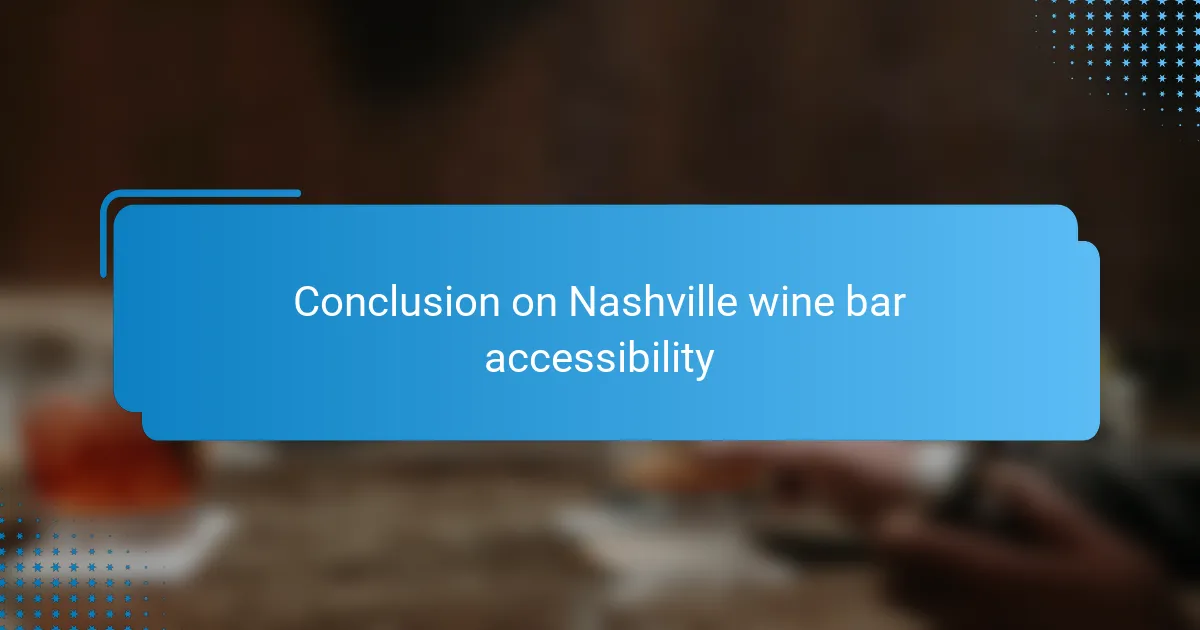
Conclusion on Nashville wine bar accessibility
Reflecting on my experiences, Nashville’s wine bars show real promise but still have room to grow in accessibility. It’s clear that many venues care deeply about creating inviting atmospheres, yet sometimes the practical details slip through the cracks. Isn’t it interesting how small adjustments, like leveling a threshold or tweaking lighting, can dramatically shift how included everyone feels?
I can’t help but think about those moments of hesitation or frustration I’ve witnessed—or felt myself—when physical or sensory barriers get in the way. It reminds me that true accessibility isn’t just checkboxes on a list; it’s about embedding empathy into the very design and service of a place. When Nashville wine bars embrace that mindset, they not only widen their audience but genuinely enrich the experience for all.
Ultimately, my takeaway is that accessibility in Nashville’s wine bars isn’t an afterthought for a few but a collective opportunity for many. I look forward to seeing more spots where thoughtful layout, clear signage, and warmly attentive staff come together seamlessly. After all, shouldn’t savoring a good glass of wine feel effortless and welcoming to everyone?
